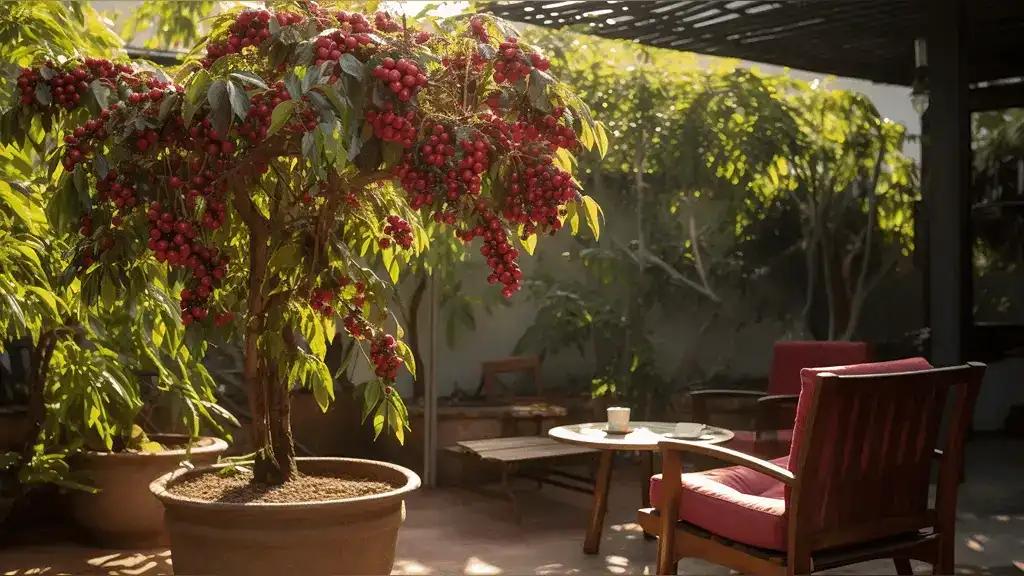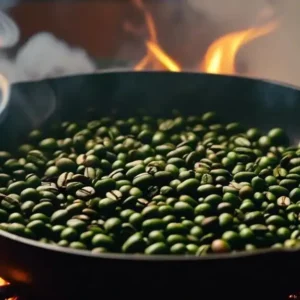Caturra coffee offers a lot more than just deliciousness! From its origins and geography to its unique flavor profile and various brewing options, it’s easy to see why this variety has become increasingly popular among specialty coffee drinkers over recent years.
Coffee lovers, get ready to learn about one of the most unique and flavorful varieties of beans on the market. This post will cover everything you need to know about caturra coffee, from its origins and growing conditions to its flavor profile, best brewing methods, and more. Let’s dive in!
An In-Depth Look at the Caturra Coffee Variety
Geographically speaking, caturra coffee beans are grown primarily in Central and South America, with Colombia typically producing some of the highest quality beans available today.
The ideal climate for growing caturra consists of warm days with temperatures typically between 75-85°F (24-30°C), along with plenty of bright sunshine throughout the day.
The trees themselves tend to be quite short in stature compared to other varieties; they produce very few branches but still manage to yield a surprisingly large amount of fruit each season.
Their leaves are larger than those found on most plants and their flowers are usually white or purple in color.
You’ve shown an interest in exploring different coffee varieties. Why not continue your journey by learning about Catimor Coffee? Uncover the fascinating insights into its cultivation and genetics. Get started here: Exploring What Catimor Coffee Is.
A Definition of Caturra Coffee Variety
Caturra is a type of coffee plant that originates from Brazil. It was first discovered in 1937 when it was found growing wild in Minas Gerais province. The plant is an offshoot of the Bourbon variety and is part of the Catimor family of cultivars. Caturra is known for its small stature, making it ideal for cultivation on steep hillsides or small plots of land where full-sized trees cannot be grown.
Are you a fan of Caturra coffee? Expand your coffee horizons even further with our in-depth Pacamara Variety Handbook. This resource is your go-to guide for understanding the various Pacamara coffee types, including valuable insights into their origins, taste profiles, and best brewing practices. Don’t miss out on becoming a true coffee connoisseur.
Harvesting Caturra Beans
When it comes to harvesting caturra beans, timing is key — they must be picked while they are still ripe so as not to lose any flavor potential during processing. The best way to ensure optimal flavor is by picking selectively; only ripe berries should be harvested while leaving unripe ones behind until they are fully mature.
Proper care must be taken during the processing stages so as not to damage any delicate parts of the bean structure that could reduce quality overall.
Ready to try your hand at cultivating Typica coffee plants? Discover the step-by-step guide to growing your very own Typica coffee beans: Cultivating Typica Beans: How-To.
Roasting Techniques
There are also several different roasting techniques that can be used when preparing caturra coffee beans for consumption; light roasts tend to work best for bringing out subtle nuances within its complex flavor profile.
Brewing Methods
There are a number of popular brewing methods available for achieving maximum aroma and flavor when enjoying these unique coffees — from pour over methods such as Chemex or Hario V60 drippers all the way through cold brews or nitro infusions — all work exceptionally well with this type of bean!
If you’re interested in learning how to make espresso without a machine, check out our comprehensive guide on How To Make Espresso Without a Machine. This guide provides step-by-step instructions and alternative techniques for crafting a delicious cup of espresso right in your kitchen.
Where Does Caturra Grow Best?
Caturra thrives in warm climates with regular rainfall; however, it can also survive in arid conditions with supplemental irrigation. It does best when planted in deep soils with ample organic matter and good drainage.
How Caturra Differs From Bourbon and Other Varieties
Unlike Bourbon coffee plants which can reach heights up to 5 feet tall, the Caturra variety usually only reaches 2-3 feet tall even when fully mature.
It also produces fewer branches than Bourbon so it requires less pruning during cultivation which leads to lower production costs for farmers growing this variety compared to others such as Typica or Catuaí Vermelho (Red Catuaí).
In terms of flavor profile, the cup produced by this variety tends to be sweet with citrusy notes, which makes it stand out from more traditional varieties like Bourbon or Typica which offer classic “coffee” flavors without much complexity or depth beyond those basic notes.
What are the Physical Characteristics of the Plant and its Beans?
- The Caturra plant is similar to Bourbon coffee plants in terms of size; however, its leaves are shorter than those found on Bourbon plants.
- Its beans are small but dense – typically weighing between 11-13 grams per 100 grains – making them perfect for espresso-style coffees or dark roasts with strong flavor profiles.
- Furthermore, these beans have a higher caffeine content than some other varieties due to their density and small size.
Growing and Cultivating Caturra
Successfully growing Caturra starts with finding ideal planting conditions as mentioned earlier:
- Deep soil with good drainage and plenty of organic matter mixed into the soil for optimal nutrition uptake by root systems during growth phases.
- After planting your seedlings in springtime (or later if you live in a warmer climate), regularly water your plants throughout their growth cycles while also applying fertilizer at least twice per season (more often if needed).
- Prune your plants every few months during growth cycles by cutting off any excess branches or leaves that may be impeding light access or air circulation around each plant’s stem area – this will help ensure healthy growth habits as well as abundant yields each season!
The Benefits of Planting the Caturra Coffee Variety
The caturra coffee variety offers many advantages over other varieties including:
- Its short stature,
- high yield potential,
- quick harvest time frame,
- ease of handpicking ripe cherries,
- enhanced air circulation within the canopy due to pruning back branches,
- deep root system which allows it access to water sources during droughts,
- low center of gravity which prevents toppling due to strong winds or storms.
- Adaptability between 18-27 degree Celsius (64 – 80°F).
All these benefits make planting this particular type a must have for any producer wanting a high quality product that will stand out among others! Let’s take a closer look at why the caturra coffee variety just might be perfect for your needs.
When Can You Expect to Harvest the First Fruits?
If planted in optimal conditions with plenty of sunlight, the caturra variety can begin producing fruit in as little as its third year. That makes it an ideal choice for producers who want to get their crop to market quickly.
How Much Spacing is Needed for Planting This Variety?
The short stature of this variety means that it requires far less spacing than other varieties when planted in fields or on large-scale farms; in fact, you can plant up to 10 plants per square meter if needed! That makes it easy to maximize space and yield potential without sacrificing quality.
Why is Handpicking Ripe Cherries Easier with Caturra Coffee?
Another great advantage of the caturra variety is its lower canopy height; that means picking ripe cherries by hand is significantly easier when compared to taller varieties such as bourbon or typica. This makes harvesting faster and more efficient while promoting better quality control over each batch of beans.
How Does Its Short Stature Help Producers?
Thanks to its shorter stature, the caturra variety can easily be pruned back which helps increase air circulation within the canopy; this reduces disease pressure and helps marketable yields stay higher throughout the season.
It also provides more light penetration into the canopy which helps promote healthy growth of new buds and leaves during fruiting periods.
While the Caturra coffee variety has its distinct characteristics and benefits, there’s a plethora of flavors in the coffee realm. Delve into the top-rated coffee varieties to see how Caturra compares with other popular flavors.
For a unique flavor experience, consider exploring the Liberica coffee flavor exploration. This variety offers a distinct taste profile that stands out from the more common coffee types.
For instance, understanding the Excelsa coffee variety details can offer a fresh perspective on coffee diversity.
What Is Its Yield Potential?
The yield potential for this variety can vary depending on location and climate; however, on average you can expect around 1 kilogram per bush in optimal growing conditions. That’s around 5-10 times what other varieties produce!
How Does It Fare During Droughts and Winds?
The caturra coffee variety is highly resistant to drought thanks to its deep root system; this allows it to access water sources even during long dry spells. In terms of wind resistance, this cultivar fares better than most due to its low center of gravity which keeps it from being toppled by strong gusts or storms.
What Temperature Range Does It Adapt To Easily?
The caturra coffee variety has been bred for optimum performance between temperatures ranging from 18-27 degrees Celsius (64-80 degrees Fahrenheit). At lower temperatures, growth slows dramatically while higher temperatures lead increased risk for fungal diseases such as coffee rust or leaf blight.
Growing Caturra Coffee Challenges and Solutions
Growing Caturra coffee presents many challenges for farmers due to diseases such as Coffee Leaf Rust (CLR) and Coffee Berry Disease (CBD).
There are other considerations such as slower ripening rate & lower yields as well as specific nutritional requirements needed for optimal growth & production.
There are solutions that can help address these issues such as cross-breeding with resistant varieties like Timor Hybrid or growing dwarf plants that are naturally resistant to CLR due to their shorter stature.
With careful planning and preparation, it is possible for farmers who want to grow caturra coffee at higher altitudes to achieve success without sacrificing quality or flavor! CoffeeScan team analyzed some of the issues faced by Caturra coffee farmers when trying to grow their crop at high altitudes, as well as some potential solutions.
Challenges Faced by Caturra Coffee Farmers
- Coffee Leaf Rust (CLR) is one of the primary challenges faced by Caturra coffee farmers. CLR is a fungus that affects many varieties of Arabica coffee plants and can cause reduced yields and decreased quality in the resulting beans.
- Coffee Berry Disease (CBD), which is caused by a soil-borne fungus and can have a devastating effect on yield if not treated early on.
- Nematode infestation can also lead to lower yields if left unchecked.
Solutions for the Problems Faced by Caturra Coffee Farmers
One solution to address the issues posed by CLR, CBD, and nematodes is cross-breeding with resistant varieties such as Timor Hybrid. This hybrid has been bred specifically to be resistant to these diseases while still maintaining its desirable flavor profile.
Other Considerations for Growing Caturra at High Altitudes
When growing Caturra coffee at higher altitudes, it’s important to consider other factors beyond disease resistance.
For example, because of the cooler temperatures at higher elevations, the beans tend to ripen more slowly than those grown closer to sea level—resulting in lower yields overall.
It’s important that growers pay attention to their plants’ nutritional needs in order for them to reach their full growth and production potentials; otherwise they may suffer from stunted growth or low fruit yield despite being disease free.

























